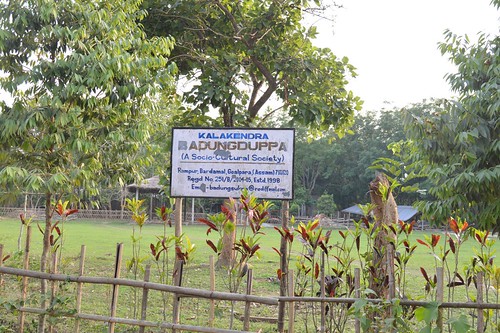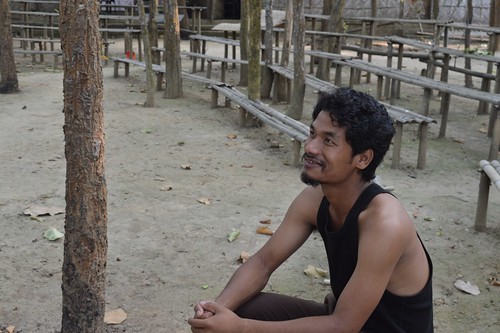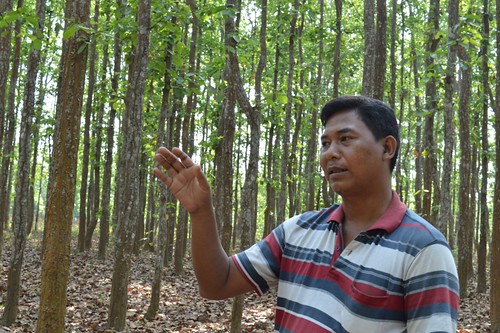By Amit Kumar, Twocircles.net
Goalpara: The idea of theatre has different connotations and meaning for different people. In its most basic form, it can be a simple story told in front of an audience; for others, theatre is synonymous with big stages and expansive props. Sukracharya Rabha, a theatre artist based out of Rampur village, Agia, Goalpara Assam, is a firm believer in the former way of storytelling. For the past two decades, he has been working hard to promote the Rabha culture and the language using theatre as a medium and connecting it to its root, along with using the medium to promote environmental awareness.

While many teenagers spend time thinking what they wish to do in life, Sukracharya faced no such dilemmas: he knew that his future lied in theatre, and even though he studied Botany in college, he never let go of his passion for theatre. Yet, he knew that given his roots and financial condition, he couldn’t afford to ‘study’ theatre. So, he chose the next best option to learn, understand, appreciate and follow theatre: workshops. In the 90s, he attended a series of theatre workshops held by the National School of Drama and in 1998, he founded the Badungduppa. “In the initial days, it was just a bare patch of land with no stage, no props and no audience,” Sukracharya says laughingly.
The Rabhas are a tribe that are spread across Meghalaya, Assam and West Bengal and have a rich history of literature and theatre. Bishnu Prasad Rabha is a name that stands out as one of the stalwarts of both Assamese and Rabha literature. For Sukracharya Rabha, Bishnu Rabha’s work played an important role in both understanding and explaining the role of theatre to the local people. “Rabhas understand theatre well and have always been a keen follower of this art, so once we set up the theatre group, we realised that instead of trying to adapt to outside audience, it made more sense to start at a local level and in the Rabha language,” he says.

Sukracharya’s biggest learning experience came when he met famous Manipuri theatre artist Heisnam Kanhailal in 2002. The grand old man of Manipuri theatre was the director of a workshop organised by the Eastern Zone Cultural Centre, under the cultural affairs department of Assam and the Srimanta Sankardeva Kalakshethra. “He was the father figure that helped me understand the nuances of theatre, and how it could be connected with the audience,” recalls Sukracharya.
It was the connect with the forest and nature that led Sukracharya to adopt a very simple form of storytelling: there were no props, no lighting except natural and all the music that was used would be played in front of the audience: no wonder, then, that the theatre group was called Badungduppa: it comes from the name of a musical instrument, traditionally used by the to get drive out the evil.
It is a form that has helped his troupe perform across the country in hundreds of shows, and while in many places the troupe performs on stage with lights, it is in the forests of Agia, deep into the Sal forests that the magic of this theatre comes out at his best. To encourage the local people, Sukracharya’s troupe consists of about 18 actors, all from nearby villages.

The Sal tree also becomes important in the context because over the past two decades, their numbers have come down substantially as people cleared forests for the more lucrative business of planting rubber trees. To make people aware about the importance of Sal trees and discourage deforestation, Sukracharya started a theatre festival called “Under the Sal Tree” in 2009. True to its name, the festival, which occurs in the month of December every year, is performed in the forest using only natural light and a makeshift stage. No artificial material is used anywhere; there are no speakers, no mikes and after the festival concludes, the actors ensure that the forests return to their natural beauty. For Basanta Rabha, one of the actors who work with Shukryacharya, the bare minimum set-up is ideal. As he explains, “in such a setup, you can see the emotions on the face of the audience. When I shout, I can see them get scared; when I act funny, I can see them laugh with me. On a conventional stage, I can’t stare into an audience’s face, but here I can. That is both a challenge, and the best part,” he says.
“The culture of theatre cannot exist without maintaining a close relationship with nature; and if theatre is my life, then the forest is the most important part of that life,” says Sukracharya. “I cannot ask people to remove the rubber trees, but I can always ask them, through theatre, to maintain the balance with nature.” Today, the festival has gained immense popularity and along with locals, it draws thousands of people from across the nation. The festival also helps raise vital funds to sustain the theatre group, and each actor is a paid member in the troupe. For all local actors, the centre is also home; and while they hone their acting skills in the centre during the residency fellowship, they are also paid an honorarium to ensure that they do not have to depend on family for sustenance.
Related:

